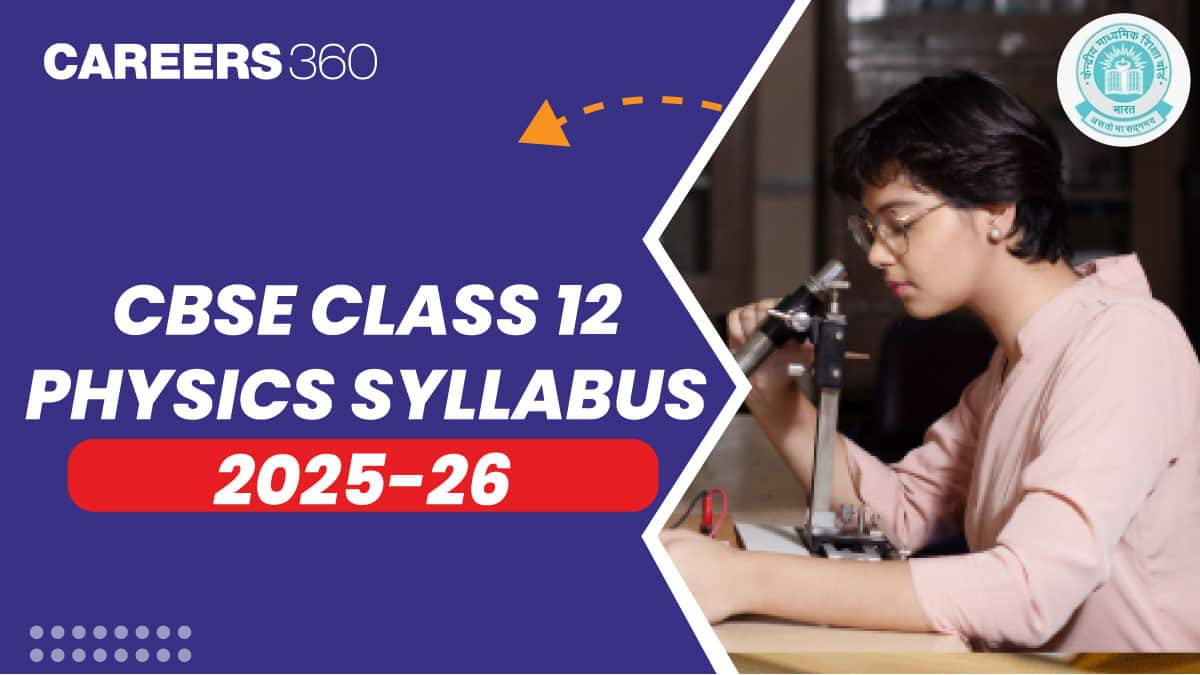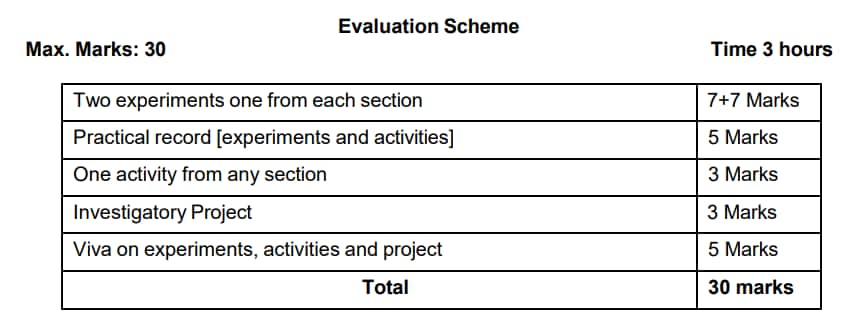CBSE Class 12 Physics Syllabus 2025-26: Download PDF, Topics & Practical Details
CBSE Class 12th Exam Date:01 Jan' 26 - 14 Feb' 26
The latest syllabus of CBSE Class 12 Physics subject is available online. Students can download the CBSE 12th Physics syllabus PDF 2025-26 from cbseacademic.nic.in. In this article, we have provided a direct download link to the CBSE Class 12 Physics syllabus 2026 PDF.
The Central Board of Secondary Education has determined the CBSE 12th Physics syllabus topics, and it is structured into nine units covering major domains like Electrostatics, Current Electricity, Magnetism, Optics, and Modern Physics. The theory paper is for 70 marks with a 3-hour duration. 30 marks are reserved for practicals/internal assessment.
Download CBSE 12th Physics 2025-26 PDF
| Subject Name | PDF Download Link |
| CBSE Class 12 Physics Syllabus 2025-26 | Click Here |
This Story also Contains
- Topics Incorporated in CBSE 12th Physics Theory Paper 2025-26
- Chapter-Wise CBSE 12th Physics Syllabus 2025-26
- CBSE Class 12 Physics Syllabus for Practicals 2025-26

Also, Download: CBSE 12th Syllabus 2025-26 (All Subjects)
Topics Incorporated in CBSE 12th Physics Theory Paper 2025-26
In the following table, students can check the topics that are a part of the CBSE 12th Physics syllabus for 2025-26, along with the marks allocation for each unit.
| Unit | Chapters | Marks |
| Unit–I | Electrostatics Chapter 1: Electric Charges and Fields Chapter 2: Electrostatic Potential and Capacitance | 16 |
| Unit–II | Current Electricity Chapter 3: Current Electricity | |
| Unit–III | Magnetic Effects of Current and Magnetism Chapter 4: Moving Charges and Magnetism Chapter 5: Magnetism and Matter | 17 |
| Unit–IV | Electromagnetic Induction and Alternating Currents Chapter 6: Electromagnetic Induction Chapter 7: Alternating Current | |
| Unit–V | Electromagnetic Waves Chapter 8: Electromagnetic Waves | 18 |
| Unit–VI | Optics Chapter 9: Ray Optics and Optical Instruments Chapter 10: Wave Optics | |
| Unit–VII | Dual Nature of Radiation and Matter Chapter 11: Dual Nature of Radiation and Matter | 12 |
| Unit–VIII | Atoms and Nuclei Chapter 12: Atoms Chapter 13: Nuclei | |
| Unit–IX | Electronic Devices Chapter 14: Semiconductor Electronics: Materials, Devices and Simple Circuits | 7 |
| Total | 70 |
Chapter-Wise CBSE 12th Physics Syllabus 2025-26
In the following table, students can find the detailed chapter-wise syllabus for the CBSE Class 12th Physics subject:
Unit No. | Chapter Name | Topics Included |
I | Chapter 1: Electric Charges and Fields | Electric charges, conservation of charge, Coulomb's law, superposition principle, continuous charge distribution; Electric field and lines, field due to point charge and dipole, torque on dipole; Gauss's theorem and applications: field due to infinite wire, plane sheet, spherical shell (inside & outside). |
Chapter 2: Electrostatic Potential and Capacitance | Electric potential, potential difference, field due to point charge, dipole, system of charges; equipotential surfaces; energy of system of charges; conductors and insulators, polarisation, capacitors in series/parallel; parallel plate capacitor with/without dielectric; energy stored in capacitor. | |
II | Chapter 3: Current Electricity | Electric current, drift velocity, mobility, Ohm’s law, V-I characteristics; electrical energy and power, resistivity, conductivity, temperature dependence; emf, internal resistance, series/parallel cells, Kirchhoff's laws, Wheatstone bridge. |
III | Chapter 4: Moving Charges and Magnetism | Magnetic field, Oersted’s experiment, Biot-Savart law, Ampere's law, solenoid, force on charge/current in magnetic field, force between conductors, torque on current loop, magnetic dipole, galvanometer and its conversion to ammeter/voltmeter. |
Chapter 5: Magnetism and Matter | Bar magnet, equivalent solenoid, field due to magnetic dipole (qualitative), torque on dipole (qualitative), magnetic materials (para-, dia-, ferro-), magnetisation, temperature effect. | |
IV | Chapter 6: Electromagnetic Induction | Faraday’s laws, Lenz’s law, induced EMF, current, self and mutual induction. |
Chapter 7: Alternating Current | AC, peak/RMS values, reactance, impedance, LCR circuit (phasor only), resonance, power, power factor, wattless current, AC generator, transformer. | |
V | Chapter 8: Electromagnetic Waves | Displacement current, electromagnetic waves, transverse nature (qualitative), EM spectrum and uses (radio to gamma rays). |
VI | Chapter 9: Ray Optics and Optical Instruments | Reflection, spherical mirrors, mirror formula, refraction, total internal reflection, optical fibers, lens formula, magnification, lens maker’s formula, prism, microscope and telescope (types, magnifying power). |
Chapter 10: Wave Optics | Wave front, Huygen’s principle, interference, Young’s double slit experiment (expression only), coherent sources, diffraction by single slit (qualitative), fringe width. | |
VII | Chapter 11: Dual Nature of Radiation and Matter | Photoelectric effect (Einstein’s equation), Hertz/Lenard’s observations, matter waves, de Broglie relation. |
VIII | Chapter 12: Atoms | Rutherford’s experiment, Bohr model, orbit radius, velocity, energy expressions, hydrogen spectra (qualitative). |
Chapter 13: Nuclei | Composition and size, nuclear force, mass-energy relation, binding energy, fission and fusion. | |
IX | Chapter 14: Electronic Devices | Energy bands (conductors/semiconductors/insulators), intrinsic/extrinsic semiconductors, p-n junction, diode characteristics, diode as rectifier. |
CBSE Class 12 Physics Syllabus for Practicals 2025-26
The CBSE Class 12 Physics practicals syllabus is mentioned in the table below. Students can have a look at the syllabus. They must maintain their practical file properly throughout the year and try to score full marks in the practical section to obtain a good final score in the subject.
Particulars | Details |
Apparatus for Identification & Familiarity | Meter scale, voltmeter, ammeter, battery/power supply, connecting wires, standard resistances, meter bridge, screw gauge, jockey, galvanometer, resistance box, potentiometer, Leclanché cell, Daniell cell, rheostat, plug-in/tapping keys, diode, resistors, capacitors, inductors, electric/electronic bell, lenses (convex/concave), mirrors (convex/concave), core/hollow wooden cylinder, insulated wire, transformer core, ferromagnetic rod. |
List of Experiments | 1. Find resistance per cm of wire (V-I graph) 2. Verify laws of resistance (series/parallel) 3. Measure resistance using a meter bridge 4. Find galvanometer resistance (half deflection method) 5. Identify the resistor, capacitor, inductor, and diode 6. Distinguish between convex/concave lenses and mirrors; estimate the power difference 7. Design inductor coil; study effects of turns and core material 8. Design a step-up/step-down transformer and study the input-output voltage relation |
Evaluation Scheme for CBSE 12th Physics Syllabus 2025-26

Tips to Prepare for CBSE Class 12 Physics Paper 2025-26
- Begin by studying the official CBSE 12th Physics syllabus. Carefully analyse the unit-wise mark distribution and make a study plan strategically.
- Study from the NCERT 12th Physics textbook. Students should not focus on reference books too much. Focus on finishing the prescribed textbook first, and then take extra help from popular CBSE 12th Physics reference books for more practice and conceptual clarity.
- Practice solving numerical problems. Also, maintain a separate formula sheet or notebook.
- Solve previous years’ question papers and CBSE 12th Physics sample papers PDF once the syllabus has been covered. Solve papers every day in a stipulated period.
- Do weekly revisions and have faith in your academic journey and grind. Stay positive and attempt the final CBSE 12th exam of Physics with a positive mindset.
Also, Check the Syllabus for Other Subjects:
Frequently Asked Questions (FAQs)
Optics (18 marks) and Magnetic Effects of Current and Magnetism (17 marks) carry the highest weightage.
The latest CBSE Class 12 Physics syllabus and marking scheme 2025-26 is available at cbseacademic.nic.in. The download link to the syllabus PDF is also provided in the article above.
Questions related to CBSE Class 12th
On Question asked by student community
Hello,
You can get the Class 11 English Syllabus 2025-26 from the Careers360 website. This resource also provides details about exam dates, previous year papers, exam paper analysis, exam patterns, preparation tips and many more. you search in this site or you can ask question we will provide you the direct link to your query.
LINK: https://school.careers360.com/boards/cbse/cbse-class-11-english-syllabus
Hello,
No, it’s not true that GSEB (Gujarat Board) students get first preference in college admissions.
Your daughter can continue with CBSE, as all recognized boards CBSE, ICSE, and State Boards (like GSEB) which are equally accepted for college admissions across India.
However, state quota seats in Gujarat colleges (like medical or engineering) may give slight preference to GSEB students for state-level counselling, not for all courses.
So, keep her in CBSE unless she plans to apply only under Gujarat state quota. For national-level exams like JEE or NEET, CBSE is equally valid and widely preferred.
Hope it helps.
Hello,
The Central Board of Secondary Education (CBSE) releases the previous year's question papers for Class 12.
You can download these CBSE Class 12 previous year question papers from this link : CBSE Class 12 previous year question papers (http://CBSE%20Class%2012%20previous%20year%20question%20papers)
Hope it helps !
Hi dear candidate,
On our official website, you can download the class 12th practice question paper for all the commerce subjects (accountancy, economics, business studies and English) in PDF format with solutions as well.
Kindly refer to the link attached below to download:
CBSE Class 12 Accountancy Question Paper 2025
CBSE Class 12 Economics Sample Paper 2025-26 Out! Download 12th Economics SQP and MS PDF
CBSE Class 12 Business Studies Question Paper 2025
CBSE Class 12 English Sample Papers 2025-26 Out – Download PDF, Marking Scheme
BEST REGARDS
Hello,
Since you have passed 10th and 12th from Delhi and your residency is Delhi, but your domicile is UP, here’s how NEET counselling works:
1. Counselling Eligibility: For UP NEET counselling, your UP domicile makes you eligible, regardless of where your schooling was. You can participate in UP state counselling according to your NEET rank.
2. Delhi Counselling: For Delhi state quota, usually 10th/12th + residency matters. Since your school and residency are in Delhi, you might also be eligible for Delhi state quota, but it depends on specific state rules.
So, having a Delhi Aadhaar will not automatically reject you in UP counselling as long as you have a UP domicile certificate.
Hope you understand.
Applications for Admissions are open.
As per latest syllabus. Physics formulas, equations, & laws of class 11 & 12th chapters
JEE Main Important Chemistry formulas
Get nowAs per latest syllabus. Chemistry formulas, equations, & laws of class 11 & 12th chapters
JEE Main high scoring chapters and topics
Get nowAs per latest 2024 syllabus. Study 40% syllabus and score upto 100% marks in JEE
JEE Main Important Mathematics Formulas
Get nowAs per latest syllabus. Maths formulas, equations, & theorems of class 11 & 12th chapters
